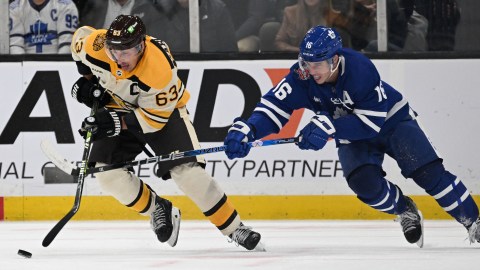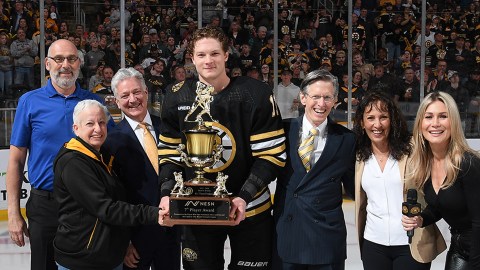There was a time when having the extra man really was an advantage for the Bruins.
Last year was not that time.
The Bruins were among the best penalty-killing teams in the league in 2009-10. Unfortunately, the power plays they thwarted most often were their own. Boston ranked just 23rd in the league on the year with a 16.6 percent success rate, and their 44 power-play goals tied for the second fewest in the NHL.
Just about everything that could go wrong on the power play last year did. The Bruins never replaced the sniping skills of Phil Kessel (eight power-play goals in 2008-09). They lost their top power-play producer in Marc Savard for half the season with a string of injuries, while Zdeno Chara’s cannon from the point was misfiring most of the year due to a hand injury. And players like Michael Ryder and Marco Sturm whom the Bruins were counting on to produce on special teams suffered through disappointing seasons.
It all added up to a frustrating season for the power play, which in turn contributed greatly to the team’s frequent struggles throughout the year.
But it doesn’t have to be this way. While coach Claude Julien could be criticized for sticking with his power-play system and unit combinations for too long, it was that same system and much of the same personnel that finished fourth in the league at 23.6 percent in 2008-09. The Bruins also showed a glimpse of their capability in this year’s playoffs, ranking fourth in the league at 24.4 percent (11-45).
So how can the Bruins get back to that sort of success and maintain it with some consistency throughout the season?
Having Savard back healthy is a crucial first step. His absence for much of last year was the biggest factor in the power play’s decline. With Savard in the lineup, the Bruins were a solid 21.7 percent (33-152). Without him, they were a woeful 9.7 percent (11-113). That 21.7 percent with Savard would have ranked third in the league over a full season, while the 9.7 percent wasn’t even within sniffing distance of Toronto’s league-worst 14.0 percent. Despite missing half the season, Savard still led the Bruins with 17 power-play points, a 34-point pace that would have outstripped even his team-high 30 power-play points in 2008-09.
Savard could be even more dangerous this year with Nathan Horton added to the lineup. Horton has seven power-play goals last year and has 37 for his career, and he should increase those numbers in Boston as he’s never had a set-up man the caliber of Savard to work with in Florida.
The Bruins should also have more skill on their second unit, with rookie Tyler Seguin likely to see action there. The club has been careful not to raise expectations too high for Seguin in his first year, but he’s too skilled not to be utilized on the power play and could give opposing penalty killers fits coming on fresh after Savard and Co. on the first unit have already run them ragged.
The Bruins also need to find a way to create more traffic in front, crash the crease and bang in the ugly goals on tips and rebounds. The Bruins did far too little of that last year, trying too often for the perfect play and over passing rather than getting the puck on net.
Veteran Mark Recchi was one of the few exceptions to that, and he was rewarded with a team-high eight power-play goals, plus another three in the postseason. Blake Wheeler, who had just three power-play goals despite averaging 2:04 a game on the man advantage, needs to make better use of his size by driving the net in a similar fashion. And Milan Lucic, who averaged just 44 seconds a game on the power play in the regular season, needs to be utilized more. He showed what parking his imposing frame in the slot could do with a pair of power-play goals in the playoffs despite continuing to average just 59 seconds a game on the man-advantage in the postseason.
After a rare good day on the power play when the Bruins struck for three goals on four opportunities in a 5-0 win over Calgary on March 27, Recchi revealed that power-play success really boiled down to the most basic level of simply outworking the opposition.
"[It’s all about getting] bodies in front and shooting pucks, retrieving pucks and working hard," said Recchi. "We did all those things. We have to continue that if we want to continue to be successful."
Another way to help that is to use Patrice Bergeron down low. Julien has put him almost exclusively on the point in recent years, but that has yielded poor results. Bergeron has only one power-play goal in the last two years combined, with no goals and just eight assists last year despite averaging 2:41 a game on the power play.
With Dennis Wideman (2:43, 13 points on power play) gone and Horton and Seguin added as options up front, Julien will be tempted to keep Bergeron on the point again this year. But he would be better served to use Bergeron’s passing skills down low and give Johnny Boychuk, Matt Hunwick and Dennis Seidenberg more opportunities to man the points along with Chara. Boychuk in particular has the kind of booming slap shot that can be a very effective weapon on the power play, and he did chip in a goal and two assists when given a chance to play in that role in the playoffs.
Julien will get some additional help this year with the addition of assistant coach Doug Jarvis to the staff, as Jarvis has plenty of special-teams experience from his days as an assistant with the Stars and Canadiens.
"[Jarvis] has also had great success in Montreal dealing with the power play," noted Julien when Jarvis was hired this summer.
The most important change the Bruins need to make, however, is simply creating more opportunities. Last year Boston had the second-fewest power-play chances in the league with 265. And that is nothing new, as they also ranked 27th in the NHL in power-play opportunities in each of Julien’s first two seasons in Boston.
Just as the Bruins need to drive the net more and outwork and out-hustle opposing teams to take advantage of their power-play chances, they need to do the same things at even strength to force the opposition into making mistakes and draw penalties. More power-play chances will naturally lead to more power-play goals just by pure volume, but additional opportunities can also lead to greater effectiveness and efficiency as more time with the man-advantage will allow the power-play units to get into a rhythm and wear down the opposing penalty killers.
NESN.com will answer one Bruins question every day in August.
Tuesday, Aug. 24: Who will play on the penalty kill this year?
Thursday, Aug. 26: Will Matt Hunwick bounce back this season or continue his struggles from last year?



